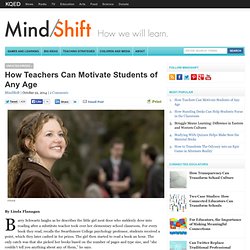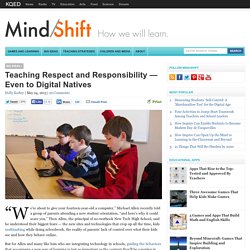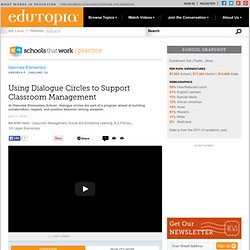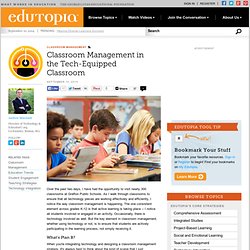

Classroom Management: The Intervention Two-Step. All of us have had major classroom disruptions that try our patience and push our limits.

These incidents can threaten our sense of control and generate fear of looking weak to other students. We fear that other students might do the same thing if we don't take a strong stance. Couple these feelings with the possibility of taking the disruption personally, and we have a recipe for disaster. It's important that we divide our response into two parts: Immediate stabilization Intervention to resolve these issues Crisis Management If you go to the emergency room, the goal is not to make you better (unless the required treatment is minor).
The same is true in the classroom. Calming down requires time for both the student and teacher to depersonalize the incident. Common wisdom tells us to intervene as fast as possible, that waiting is a bad thing. Do's, Don'ts and 5 Examples Understand that stabilizing is not excusing, letting the student get away with anything or ignoring. Privacy Concerns for ClassDojo and Other Tracking Apps for Schoolchildren. Photo HUNTER, N.Y. — For better or for worse, the third graders in Greg Fletcher’s class at Hunter Elementary School always know where they stand.

One morning in mid-October, Mr. Fletcher walked to the front of the classroom where an interactive white board displayed ClassDojo, a behavior-tracking app that lets teachers award points or subtract them based on a student’s conduct. On the board was a virtual classroom showing each student’s name, a cartoon avatar and the student’s scores so far that week. How Teachers Can Motivate Students of Any Age. iStock By Linda Flanagan Barry Schwartz laughs as he describes the little girl next door who suddenly dove into reading after a substitute teacher took over her elementary school classroom.

For every book they read, recalls the Swarthmore College psychology professor, students received a point, which they later cashed in for prizes. 4 Ways to Handle Tough Kids in Classrooms. 5 Common Mistakes that Will Lead to an Out-of-Control Classroom. Guest post by Linda Kardamis at Teach 4 the Heart My first year teaching was not very pretty.

I thought I knew how to manage a class, but I made some critical errors that left me in the situation every teacher dreads – standing in front of an out-of-control classroom. While I certainly don’t want to go back and repeat that first year, I’m very thankful for the lessons I learned. And once I learned from my mistakes and corrected them, the next year went much more smoothly. Effective classroom management can be challenging, but the key is to keep learning and growing. 30 Techniques to Quiet a Noisy Class. One day, in front 36 riotous sophomores, I clutched my chest and dropped to my knees like Sergeant Elias at the end of Platoon.

Instantly, dead silence and open mouths replaced classroom Armageddon. Standing up like nothing had happened, I said, "Thanks for your attention -- let's talk about love poems. " I never used that stunt again. After all, should a real emergency occur, it would be better if students call 911 rather than post my motionless body on YouTube. I've thought this through.
Most teachers use silencing methods, such as flicking the lights, ringing a call bell (see Teacher Tipster's charming video on the subject), raising two fingers, saying "Attention, class," or using Harry Wong's Give Me 5 -- a command for students to: Focus their eyes on the speaker Be quiet Be still Empty their hands Listen.
Teaching Respect and Responsibility — Even to Digital Natives. “We’re about to give your fourteen-year-old a computer,” Michael Allen recently told a group of parents attending a new student orientation, “and here’s why it could scare you.”

Then Allen, the principal of no-textbook New Tech High School, said he understood their biggest fears — the new sites and technologies that crop up all the time, kids multitasking while doing schoolwork, the reality of parents’ lack of control over what their kids see and how they behave online. But for Allen and many like him who are integrating technology in schools, guiding the behaviors that accompany a new way of learning is just as important as the content they’ll be covering in school — if not more so. In order to be successful, Allen maintains that students need to learn trust, respect and responsibility for technology. Allen also believes adults should set the boundaries for where and when not to use tech.
He cites a recent example of taking biology students on a field trip to a nearby river. Using Dialogue Circles to Support Classroom Management. Overview: Promoting Positive Behavior Dialogue circles are gatherings in which all participants sit in a circle facing each other to facilitate open, direct communication.

Classroom Management in the Tech-Equipped Classroom. Over the past two days, I have had the opportunity to visit nearly 300 classrooms at Grafton Public Schools.

As I walk through classrooms to ensure that all technology pieces are working effectively and efficiently, I notice the way classroom management is happening. The one consistent element across grades K-12 is that active learning is taking place -- I notice all students involved or engaged in an activity. Occasionally, there is technology involved as well. But the key element in classroom management, whether using technology or not, is to ensure that students are actively participating in the learning process, not simply receiving it. Positive, Not Punitive, Classroom-Management Tips. This article is adapted from Larry's new book, Self-Driven Learning: Teaching Strategies for Student Motivation.

Let's start with a question I've been asked on more than one occasion. "I know my content and like my students, but sometimes it's hard to get them under control so I can teach my lesson. What tips for classroom management can you give me? " My general answer is that you can never have too many positive, not punitive, classroom management strategies in your toolbox. Obviously, there are serious student transgressions, including violence, where some kind of punishment is an appropriate response.
The Dos and Don'ts of Classroom Management: Your 25 Best Tips. Posted 08/20/2014 1:55PM | Last Commented 03/29/2016 9:48AM Classroom management is a delicate balancing act often learned through experience and trial-and-error experimentation.

Whether you're a new or experienced teacher, having strategies for effective classroom management is essential for creating positive, successful learning spaces (and staying sane!). Back to School: Rules and Routines in the Classroom. I admit it. I allowed students to chew gum in class. Why? I chewed gum. Why so many kids can’t sit still in school today. The Centers for Disease Control tells us that in recent years there has been a jump in the percentage of young people diagnosed with Attention Deficit and Hyperactivity Disorder, commonly known as ADHD: 7.8 percent in 2003 to 9.5 percent in 2007 and to 11 percent in 2011.
The reasons for the rise are multiple, and include changes in diagnostic criteria, medication treatment and more awareness of the condition. In the following post, Angela Hanscom, a pediatric occupational therapist and the founder of TimberNook, a nature-based development program designed to foster creativity and independent play outdoors in New England, suggests yet another reason more children are being diagnosed with ADHD, whether or not they really have it: the amount of time kids are forced to sit while they are in school. This appeared on the TimberNook blog. 7 Tips for Better Classroom Management. In my mind, the first and most basic obligation of a teacher is to see the beauty that exists within every student. Every child is infinitely precious. Period. When we start from this vantage point, classroom management -- and its flip side, student engagement -- comes more easily.
It's an outgrowth of students feeling loved and respected. This video, shot in the first few days of my classroom in 2010, and the seven tips below will show how I try to put these ideas into practice. 1. Love them -- and stand firmly against behavior that doesn't meet your expectations or reflect their inner greatness. Creating a Welcoming and Intellectually Challenging Classroom. As you set up your classroom for the new school year, try spending a few minutes in your students' chairs. Are you comfortable? Now look closer: Will the seating arrangement invite conversations between students, or keep them isolated? What do you notice about what's on display around the room? Will students see themselves and their families reflected in the diversity of images and books? Are whiteboards, laptops, and other tools for learning within reach for students, or reserved for the teacher?
Veteran educators Dorothy M. Their book, Identity Safe Classrooms: Places to Belong and Learn (Corwin, 2013), offers thoughtful advice, grounded in research and practice, that's worth considering throughout the school year. Disorganized Classroom, Disastrous School Year - Coach G's Teaching Tips. Four Skills to Teach Students In the First Five Days of School. Jane Mount/MindShift The first few days of school are a vital time to set the right tone for the rest of the year. Many teachers focus on important things like getting to know their students, building relationships and making sure students know what the classroom procedures will be. While those things are important, Alan November, a former teacher-turned-author and lecturer says the most important ideas to hammer home will help students learn on their own for the rest of the year. “The name of the game is to find the right information with the right question,” said November during a workshop at the 2014 gathering of the International Society of Technology in Education in Atlanta.
“My job used to be to give you the information, now my job is to teach you how to find the information.” “The best teachers were kids who had really struggled with the material and really understand what it’s like to learn.” “Kids literally take their teachers assignment and Google it,” November said. Relationship Building Through Culturally Responsive Classroom Management.
7 Tips for Better Classroom Management. "What Did You Call Me?" – How to Remember Students’ Names. It’s a common predicament for educators. They familiarize themselves with students quickly, but can’t easily retrieve names on demand. Back to School: A Surefire Strategy for Building Classroom Community. Unlike many of the current posts and articles in educators' discussions these days, this post does not address anything related to technology or the CCSS. It addresses a topic of much greater importance -- the emotional environment of the classroom. Without an excellent, intentionally designed, emotional environment (one which builds authentic community in the classroom), the standards and the technologies are of little value. The 5 Critical Categories of Rules. Choices and Limits. 8 Tips for Reaching Out to Parents. Throw Out Your Seating Chart and Try One Of These 7 Ideas Instead. Class Reward System in Action. Behavior 101: Super Student Drops!
I just finished "updating" the cover and instructions for the first product that I posted on Teachers Pay Teachers. Here is the first cover. Teenagers Are Wired for Peer Approval, Study Says. 5 Things You Should Say to Your Class Every Day. Giving Good Praise to Girls: What Messages Stick. How to praise kids: It’s a hot topic for many parents and educators. A lot of the conversation around it has stemmed from studies by Carol Dweck, professor of psychology at Stanford who has been researching this specific topic for many years. Misunderstanding Self-Esteem - Walt Gardner's Reality Check. Title 1 School How to Motivate!!! PLEASE READ!!! It's more than just motivating. Buttercup53 , Sixth grade social studies teacher in Texas. The Power of the Positive Phone Call Home. When I first started teaching and was overwhelmed by the demands and complexity of the job, my survival strategy was simply to take all the advice that came my way and implement it.
So when my wise mentor suggested that after the first day of school I call all of my second grader's parents, I did so. Spice Up Your Class Routine. Can Incentives Make Students Secretly Hate Us? - EdTech Researcher. New Year's Resolution: Classroom Procedures, Not Rules - Coach G's Teaching Tips. Closing the Achievement Gap One Student at a Time. Motivating Students: Principals Share Best Ideas. The Effect of Affect - Coach G's Teaching Tips. Five Practices for Building Positive Relationships With Students. Teaching Secrets: Get to Know Students Through Seating Challenges. Response: Several Ways We Can Help Students Develop Good Habits - Classroom Q&A With Larry Ferlazzo. Response: Several Ways to Connect With Disengaged Students - Classroom Q&A With Larry Ferlazzo.
Response: Several Classroom Management Ideas For Younger Students - Classroom Q&A With Larry Ferlazzo. Grade the Work, Not the Behavior. Classroom Management That Creates Harmony Instead of Hostility. Supporting Self-Regulation in the Classroom. 10 Things You Can Do In (About) 10 Minutes For A Better Classroom. Bad Boys: Educating the Most Difficult Students - View From the Bronx: An Urban Teacher's Perspective. Back to School: Rules and Routines in the Classroom. July/August 2012 eSchool News. Response: Several Classroom Management Ideas For Younger Students - Classroom Q&A With Larry Ferlazzo. The Art of Setting Boundaries. 7 Ways to Make Teaching Life Easier. Are You Enabling 'Academic Entitlement' in Students? - Inside School Research. Response: Don't Wait Until Christmas To Smile - Classroom Q&A With Larry Ferlazzo.
Are You Enabling 'Academic Entitlement' in Students? - Inside School Research. Experienced Teachers Reflect on Their First Year. Ten Tips for Classroom Management (available in Spanish) Back to School: Rules and Routines in the Classroom. Top 16 Classroom Control and Management Tips. How to Work With the No-Homework Kid. Tools for Teaching: Managing a Large Class Size. Classroom Management Issues - View From the Bronx: An Urban Teacher's Perspective. Let’s Not "Fall" Behind: Three Tips to Help You Stay Organized. Let’s Not "Fall" Behind: Three Tips to Help You Stay Organized.
Defusing Power Struggles: It's Not About Getting the Last Word. Classroom Management: More Than a Bag of Tricks. The Zen of Classroom Management - Teaching Now. From Struggling Teacher to Star Teacher - Coach G's Teaching Tips. Fair Isn’t Equal: Seven Classroom Tips. How Tough Kids Can Make Us Better Teachers. A Peaceful, Loving, and Productive Start of Class - Coach G's Teaching Tips. Eye On Education. Lighter Classroom Atmosphere, Tighter Classroom Management - Coach G's Teaching Tips. Forget Consistent And Fair. Try Random. 10 Things You Can Do In (About) 10 Minutes For A Better Classroom. Tips for Beating the Clock in the Classroom. 8 Classroom Management Tips. R-E-S-P-E-C-T: How to Build an Effective Classroom Environment in a Multilingual Classroom.
Classroom Management Theorists and Theories/William Glasser. A Collection of Quiet Cues, Attention Getters. Letting Go of the Reins to Allow for Student Self-Advocacy -Originally ran on Finding Common Ground on 12/31/2013. 5 Ideas for Classroom Management on a Budget. Training the Brain to Listen: A Practical Strategy for Student Learning and Classroom Management. Solving the Hand Raising Problem. Classroom Management: The Intervention Two-Step. 25 Attention-Grabbing Tips for the Classroom. What to Do About ... Students Who Seek Attention. Classroom Management. Top 10 Classroom Management Tips for Teachers - AmpliVox Sound Systems Blog. 5 Common Mistakes that Will Lead to an Out-of-Control Classroom.
The Beauty of Losing Control: Part 2. The Beauty of Losing Control: Part 1. Stressful Student Experiences: What Not to Do. Establish a Positive Climate. Creating a Safe Classroom Environment. Set Behavior Expectations. "Magic" Sentences Prevent Conflict. Dealing With Students' Feelings or Problems. Education Week.